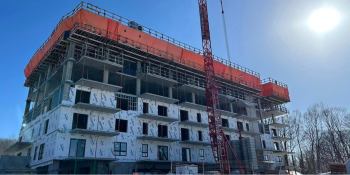Q&A Forums
Stacking - Maybe I need a better explanation of the process Post New Topic | Post Reply
| Author | Comments |
|---|---|
|
Posted: Oct 06, 2010 03:35 PM
|
Stacking - Maybe I need a better explanation of the process
Does anyone have any experience stacking one pass on top of the other. Just got finished doing a 28,000 sq. ft 5" tapered foam roof and moving on to a 3" roof.I think that it was Jim that had mentioned that on thicker roofs, he would lay 1" to 1 1/2" passes down then overlap on the immediate next pass and get 3". Am I trying to overlap 50% over the previous pass and then tying in with the next pass. So basically I am only making 3" on about 1 1/2ft of my pass, then tying in again for the same. I played around with this, but it seems the thicker my passes are, the less dense the foam became. Maybe it was my imagination though. I had to keep anyone off of it for a few minutes so that it would harden up and not crack. Are there any technical documents to explain this process a little better, or am I better off just making 4 each 3/4" passes to get my 3" thickness. Also, the thicker I sprayed the foam, it had a tendancy to not necessarily roll over, but the texture was similar to the texture of for lack of a better term, a human brain. Please explain if possible! |
|
Benjamin Skoog
Posted: Oct 06, 2010 08:04 PM
|
When spraying multiple lifts I typically do one inch at a time. I have seen foam sprayed at 2.5 inches nice and flat but, when you do something else and look back, it has actually grown to 3 inches in the middle. This is from the exothermic reaction running away and causing the blowing agent to get trapped creating enlarged cells. not a good idea one puncture in the coating and the foam becomes saturated. 1.5 inches is doable but I think it is starting to stretch it. I would be the most comfortable with one inch passes. |
|
Benjamin Skoog
Posted: Oct 07, 2010 09:53 PM
|
I was thinking about this a little more today and brain texture you are talking about, in my experience, comes from holding the gun a little to close to the substrate. Try holding the gun a little higher. For myself when I spray I typically have my arm at a right angle 90 degrees and it comes out the best for me. I am 6 feet so that is roughly 3.5-4 feet off the deck. A lot of this has to do with what tip are you using, hows the weather, what pressure are you running, and foam temps. I too have done the 50% overlap, I find it works the best on metal roofs. experiment a bit and good luck! |
|
Daniel X
Posted: Oct 08, 2010 12:08 AM
|
The texture you're getting has a lot to do with the temperature of your chemical and how clean your tip is. The product I spray cannot be sprayed in lifts greater than 2" as per the manufacturers spec. I would do my best to avoid lifts less than 1" to ensure you're getting good yield and a consistent density regardless of overall finished thickness of your foam. If you can lay down 1.5" smoothly and you're shooting for 3" overall, then go for it. I imagine the 'rolling' you're getting has more to do with the angle of the gun compared to the substrate than anything. Not sure what gun you use, but can you maintain a nice round pattern all day, or do you need to clean your gun all day? |
|
Posted: Oct 08, 2010 08:36 AM
|
This was a fairly difficult job due to exterior temperatures. The hose temperature on the roof without any heaters on were commonly in the mid to high 130's. Typically, I would leave the hose heat off till late in the afternoon when it would start dipping in the low 120's. On a side to side pattern spraying, I tend to have to clean the tip quite a bit to eliminate any fingers while I am spraying. On an oval spray pattern, the tip is not as big of a concern to me since I am moving my hands fairly quick in an oval pattern 3-4 times over the same area. Both patterns give me a smooth look though. The side to side pattern doesn't really leave a lot of room for error though. If one of the guys jerks the hose or something, it will have a washboard effect on that area, whereas on the oval pattern it won't matter much. The "brain" texture that I was speaking of was on a strong windy day and appeared to cause slight ripples as the foam began to rise and harden. My angle may have been slightly off having the bottom of my spray pattern a few inches off of my feet. I have a hard time building thick lifts though in excess of 1" or so. Maybe I am being too impatient, but with a 40 Pound per minute machine, a standard pass walking backwards med-slow is only about 5/8" on a 3 ft wide pass, which is just outside my shoulders. Taking slow small steps only gives me 3/4" or so. This may have something to do with spraying true 3.0 foam and not 2.5 or 2.7 though. Ben or dl123, what is the common width of your passes? |
|
Benjamin Skoog
Posted: Oct 08, 2010 10:43 PM
|
I typically spray about six foot passes but here is my secret spray technique... as long as you know what the spray pattern looks like, and you hold the gun accordingly, you should be able to spray with your eyes closed. The secret is in listening to the sound of the foam hitting the deck. foam starts to make a distinctive almost hollow sound when you spray a one inch pass. of course hot weather is definitely a challenge to spray in. When I sprayed in Phoenix I just made sure I always had somewhere to spray. practice keeping that gun going all the time. In hot weather I typically used a 04 chamber and no hose heat. ... btw that sound trick doesnt work so great in colder weather |
|
Posted: Oct 10, 2010 08:01 PM
|
Ben, There are very few people in the foam industrie today that can spray with there eyes closed. It takes alot of practice, I have been spraying 22 years + and when I get tired or when the wind is blowing 30+ I close my eyes. Bayouboy make sure you prime between layers, if your foam has been sitting for more than 4-5 hours. I did a project about 400,000 sq ft and here in florida at times we can start spraying at 8:30 -9:00 in the mornign and put our first passes down then come back around 2:00 - 3:00 to put pour final pass on it and then base coat. We are finding with these new foams that the top shell is alot harder and the foam is not bonding back to its self with out primimg so we are having the top layer peeling off with in a year of finishing the roofs. Then the manufacture whats to blame it on applicators error,like always. Just a little help. |
|
mason
Posted: Oct 11, 2010 11:18 AM
|
Steve, Be careful with lifts greater than 1 inch. It will produce a lower density foam that is less dimensionally stable. Good luck, give me a call to discuss. |
|
Gerry Wagoner
Posted: Nov 21, 2010 02:00 PM
|
04 tip in P2 (if the roof is large enough and clean enough) 1.5" passes for us on 3" or 1.5" roofs. 1" passes on 2" roofs (can do in one pass with skill). The less interplys the better in our experience. There was a brief time 30 years ago when prevailing advice in the industry was .5" passes. Glad those days are gone. Close eyes as needed. Or focus on something else other than the roof under your feet. You can control the thickness with your feet once you have developed a good comfortable arm technique. Have fun. `oG |





























